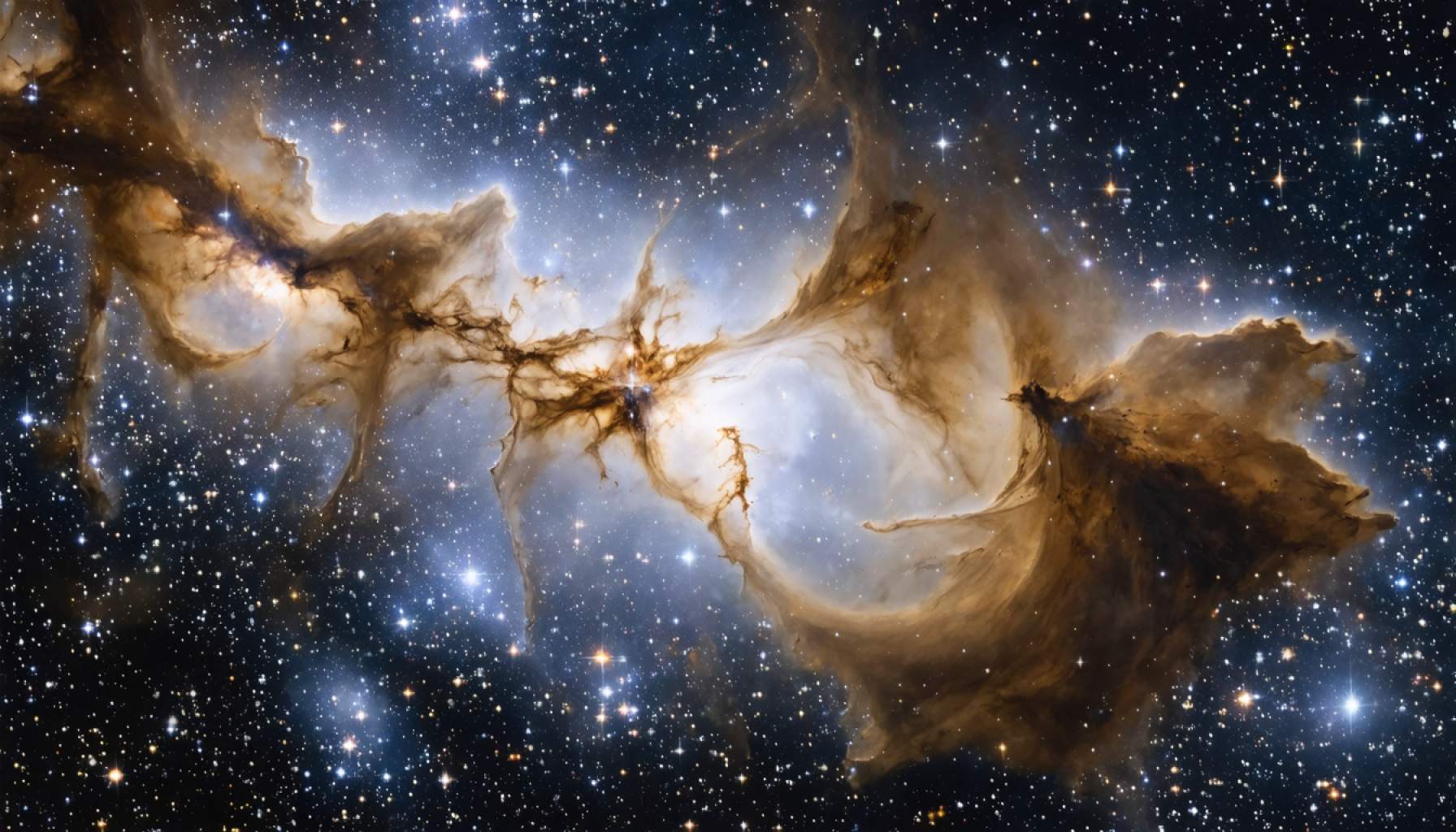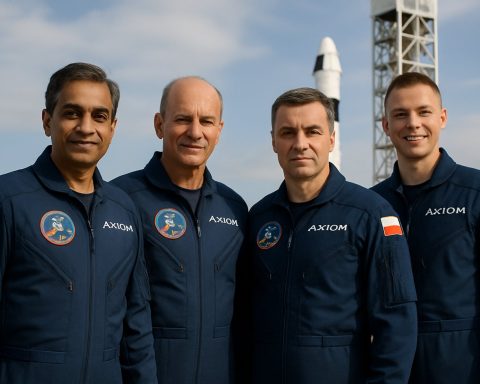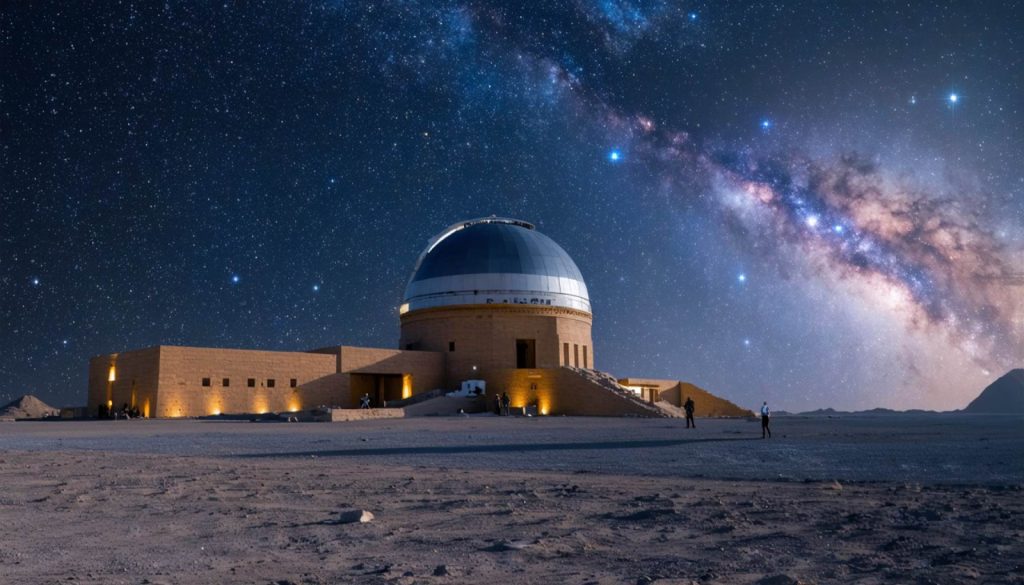- The James Webb Space Telescope captures a stunning image of the Carina Nebula, revealing the formation of young stars.
- The advanced infrared capabilities pierce through dust, offering insights into early stellar evolution and solar system formation.
- The Carina Nebula, 7,500 light-years away, is a massive star-forming region where stars and planets continue to evolve.
- Jets from newborn stars illuminate the surrounding hydrogen, unveiling the cosmic dance of gravity and nuclear fusion.
- The nebula embodies the cyclical nature of the universe, with stellar births and deaths seeding elements for future life.
- Studying these cosmic processes helps scientists understand the origins of our solar system and the potential for life beyond Earth.
- Webb’s image challenges us to reflect on our place in the universe and the enduring quest for knowledge.
A cosmic ballet unfolds in the vast expanse of the universe, as revealed by a stunning image captured by NASA’s James Webb Space Telescope. This 2022 image peers deep into the Carina Nebula, a stellar nursery where young stars announce their presence with flamboyant jets and exuberant outflows.
In this otherworldly scene, tendrils of dust and gas weave themselves into an intricate tapestry, shrouding vibrant newborn stars. Hidden for eons, these stellar infants are caught in the act of formation—a spectacle rarely witnessed with such clarity. Their vigorous jets, like celestial rivers of energy, carve luminous channels through the prevailing darkness, lightening the surrounding hydrogen with incandescent brilliance. Here, the delicate dance between gravity and nuclear fusion unveils itself, painting the cosmos with striking hues of red and blue.
Webb’s Ardent Vision
With the advanced infrared capabilities of the James Webb Telescope, astronomers pierce the shroud of dust that veils these nascent stars. This enables a breathtaking glimpse into the early stages of stellar evolution—events foundational to understanding the lifecycle of stars and the formation of solar systems. Webb’s observations promise a transformative leap in knowledge, deciphering the complex interplay of processes that ignite new stars from swirling clouds of cosmic material.
An Awe-Inspiring Locale
The Carina Nebula, situated some 7,500 light-years away in the constellation Carina, is one of the Milky Way’s largest star-forming regions. This galactic forge continues to shape the destiny of the stars and planets therein. In this spectacular stellar factory, massive stars die in explosive supernovas; their remnants seed the nebula with the elements necessary for future generations of planets and potentially, life.
Beneath the dramatic arches of the Nebula’s pillars, the visual poetry tells a larger story of the universe’s cyclical nature—the eternal return of birth and demise, decay and renewal. Each illuminated pillar is a testament to the power of stars both young and ancient, silently sculpting their surroundings across vast epochs.
The Promise of Discovery
What makes this celestial panorama truly compelling is the promise of discovery it holds. By studying the mechanisms guiding these young stars and their violent births, scientists inch closer to unraveling the mysteries of our own origins. Understanding these cosmic processes provides invaluable insights into how our solar system, and by extension our planet, came to be.
The image from James Webb stirs the imagination, urging us to look up and reflect on our place in the boundless universe. As we gaze into the depths, the curtain is drawn back just a little more, allowing humanity a fleeting yet profound glimpse of our entwined fates with the stars. Such discoveries remind us of the vast tapestry of life and the curious, ever-driven spark of human inquiry that lights our path among the stars.
Unveiling the Secrets of the Universe with James Webb: Exploring the Carina Nebula
The Importance of the James Webb Space Telescope
The James Webb Space Telescope (JWST), launched in December 2021, is the most advanced space observatory ever constructed. Its intricate instruments, such as the Near Infrared Camera (NIRCam) and the Mid-Infrared Instrument (MIRI), allow scientists to pierce through cosmic dust and glimpse into the universe’s earliest stages. Unlike its predecessor, the Hubble Space Telescope, JWST primarily observes the universe in infrared, granting it the unique ability to peer through masses of dust and uncover hidden cosmic structures and phenomena. According to NASA, this new window into the cosmos may fundamentally reshape our understanding of space, time, and the complex mechanisms that govern the universe.
Understanding Stellar Nurseries: The Carina Nebula
Features and Specs
Located approximately 7,500 light-years away from Earth, the Carina Nebula (NGC 3372) is a sublime region hosting a multitude of star births. This stellar nursery is one of the largest in our Milky Way galaxy and home to several massive stars, including the enigmatic Eta Carinae—a stellar system on the brink of a supernova. The nebula spans over 300 light-years, a vast complex of glowing gases and dark dust lanes that provide the raw materials for star formation. The Webb Telescope’s high-resolution imagery allows researchers to observe the finest details of these tumultuous environments, giving clues about the structure and evolution of massive stars.
Cosmic Processes in the Carina Nebula
How-Star Formation Works
The process begins in dense, cold clumps of gas and dust. As gravity pulls the material together, it coalesces, forming protostars. Over time, as these young stars gather more mass, nuclear fusion ignites in their cores, leading to the brilliant outpour of energy observed as jets. The energy from these jets begins to carve pathways through the surrounding dust, creating the spectacular luminous channels viewed in Webb’s images. Studying this process reveals much about how stars like our Sun came into existence and how planetary systems form around them.
Real-World Impact: What These Observations Mean for Us
Insights and Predictions
1. Solar System Formation: Webb’s observations of the Carina Nebula can illuminate the processes that led to the formation of our solar system and the potential for life-supporting planets elsewhere in the universe.
2. Elemental Distribution: By analyzing star-forming regions, scientists can better understand how essential elements like carbon, nitrogen, and oxygen are distributed throughout galaxies.
Market and Industry Trends
– Increased Investment in Space Exploration: As ground-breaking data continues to pour in from JWST, expect heightened interest and investment in space exploration technologies. The commercial space industry is poised to grow, with companies exploring opportunities in satellite technology, astronomical research, and even space tourism.
Controversies & Limitations
Despite its remarkable success, the JWST has faced challenges and scrutiny. Cost overruns and delays plagued its development, making it one of the most expensive and ambitious space science projects ever. Critics argue that funding could instead support projects addressing immediate Earthly concerns. Additionally, the fixed lifespan of approximately 10 years means time constraints are a crucial factor in mission planning.
Recommendations and Quick Tips for Stargazers & Enthusiasts
1. Stay Updated: Follow NASA and ESA’s official websites or Twitter feeds for the latest updates and discoveries from the James Webb Space Telescope. [NASA](https://www.nasa.gov) and [ESA](https://www.esa.int) are great starting points.
2. Explore Data Yourself: Amateur astronomers and enthusiasts can access raw data through public archives like the Mikulski Archive for Space Telescopes (MAST).
3. Engage with Community: Join online forums and local astronomy clubs to share knowledge and observations. Platforms like Reddit’s Astronomy community provide a space for such discussions.
By understanding these cosmic phenomena, we not only broaden our comprehension of the universe but also enrich our appreciative grasp of our place within the vast cosmic tapestry.











